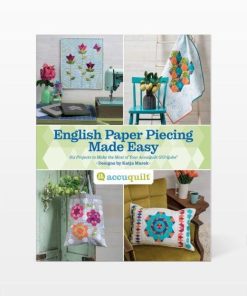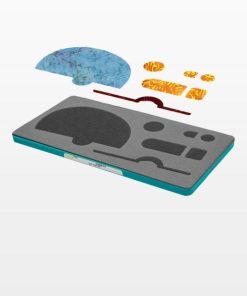GO! Storm at Sea – 12” Finished (#55221) AccuQuilt
$ 175,99 $ 70,40
- First pass through the cutter:Â
- Fabric Color 1 (dark):Â Cut four 9 1/2″ x 4″ rectangles and place over shapes A and E. Cut one 4″ square and place over shape F.Â
- Fabric Color 2 (light):Â Cut four 8 3/8″ x 3″ rectangles (two facing up and two facing down or fanfold) and place over shapes B, D and G.Â
- Fabric Color 3 (medium):Â Cut four 2 1/2″ squares and place over shape C. Cut two 4 3/8″ squares and place over shapes H.Â
- Second pass through the cutter:Â
- Fabric Color 1 (dark):Â Cut four 2 7/8″ squares and place over shape E.Â
- Fabric Color 2 (light):Â Cut four 4 1/2″ x 3″ rectangles and palce over shape B. Cut six 2 1/2″ x 1 3/4″ rectangles and place over shape D.
- Third pass through the cutter:Â
- Fabric Color 2 (light):Â Cut six 2 1/2″ x 1 3/4″ rectangles and place over shape D.Â
- Storm at Sea is a Block on Board® (BOB®) die which means it’s specially designed to include all the shapes on one die board to create a 3-color, 9†finished repeating block.Â
- No templates, no special rulers and no paper piecing! Storm at Sea includes 8 basic shapes that can be time-consuming to cut by hand.
- Storm at Sea includes highly requested 60° Diamond in a Rectangle for the sashing.
- Storm at Sea features specialized dog-ears and includes 1/4†seam allowances for easy alignment and piecing.
- Storm at Sea includes screen printed letters on die for easier piecing and organization of shapes.
- Packaging includes step-by-step sewing instructions to make constructing the block easy. Plus, a free pattern to get you started.
- Fat Quarter-friendly
AccuQuilt Benefits:Â
- Cut so much more fabric in less time.Â
- Get accurate cuts every time — No slipping rulers or mistakes
- Easiest to use — Simply place die on cutter, then fabric and cutting mat on top
- Save fabric with Two Tone Foam — Get more out of your fabric by placing it only over the shape you want to cut.Â
- Safe to use — No blades come anywhere near your fingers
Die Tips:Â
- With some fabrics, after cutting, a thread or two will remain where die blades meet. Snip threads with scissors.Â
- Blades on some dies are positioned at an angle. Align fabric to edge of shape, not edge of die board.Â
- Use good quality fabric to reduce fabric stretch.Â
- It’s always a good idea to test cut one shape before cutting many shapes to ensure fabric orientation is correct.Â
Fast Shipping and Professional Packing
Thanks to our longstanding association with UPS FedEx DHL and other leading international carriers, we are able to provide various shipping options. Our warehouse employees will pack every item to our exacting specifications. Your goods will go through an exhaustive inspection and securely secured prior to being delivered. We ship to thousands clients each day across multiple countries. This shows our commitment to be the largest online retailer in the world. Warehouses and distribution centers are located in Europe and the USA.
Orders with more than 1 item are assigned processing times for each item.
Before shipment, all ordered items will be thoroughly examined. Most orders today are shipped in 48 hours. The delivery estimate is between 3-7 days.
Returns
The inventory is constantly changing and we cannot control it completely because several parties are involved, including our factory and warehouse. The stock can change at any time. Be aware that your order will run out of stocks when you have placed the order.
Our policy is valid for 30 days. We will not return or exchange your purchase after 30 days from the date of purchase.
In order to be eligible for a refund your product must be unopened and in the same condition as when you received it. The item must be returned in its original packaging.
Related products
AccuQuilt Cutting Die
AccuQuilt Cutting Die
AccuQuilt Cutting Die
AccuQuilt Cutting Die
AccuQuilt Cutting Die
GO! Circle – 1 1/2″, 1 3/4″, 2 1/4″, 2 1/2″ (#55155) AccuQuilt
AccuQuilt Cutting Die
AccuQuilt Cutting Die
AccuQuilt Cutting Die
AccuQuilt Cutting Die
AccuQuilt Cutting Die
AccuQuilt Cutting Die
AccuQuilt Cutting Die
AccuQuilt Cutting Die
AccuQuilt Books and CDs
English Paper Piecing Made Easy Pattern Book by Katja Marek (#55188) AccuQuilt
AccuQuilt Cutting Die
AccuQuilt Cutting Die
GO! Carefree Alphabet Lowercase Set (2 – Die Set) (#55491) AccuQuilt
AccuQuilt Cutting Die
GO! Blazing Star – 6” Finished by Eleanor Burns (#55051) AccuQuilt
AccuQuilt Accessories
GO! Big Electric Fabric Cutter Power Cord Replacement (#100471-001) AccuQuilt
AccuQuilt Cutting Die
AccuQuilt Cutting Die
GO! Apple Core – 6 3/4″ (6 1/4″ Finished) (#55036) AccuQuilt
AccuQuilt Cutting Die
AccuQuilt Cutting Die
GO! Bowties – 4″ Finished by Alex Anderson Die (#55413) – Discontinued AccuQuilt
AccuQuilt Cutting Die
GO! Boxed Bag by Carolina Moore (2 – Die Set) (#55529) AccuQuilt
AccuQuilt Cutting Die
AccuQuilt Cutting Die
AccuQuilt Cutting Die
AccuQuilt Cutting Die
AccuQuilt Accessories
AccuQuilt Cutting Die
AccuQuilt Cutting Die
AccuQuilt Cutting Die
GO! Big Double Wedding Ring – 12 1/2” Finished (#55258) AccuQuilt
AccuQuilt Cutting Die




































